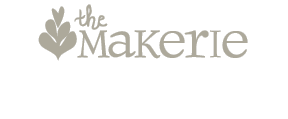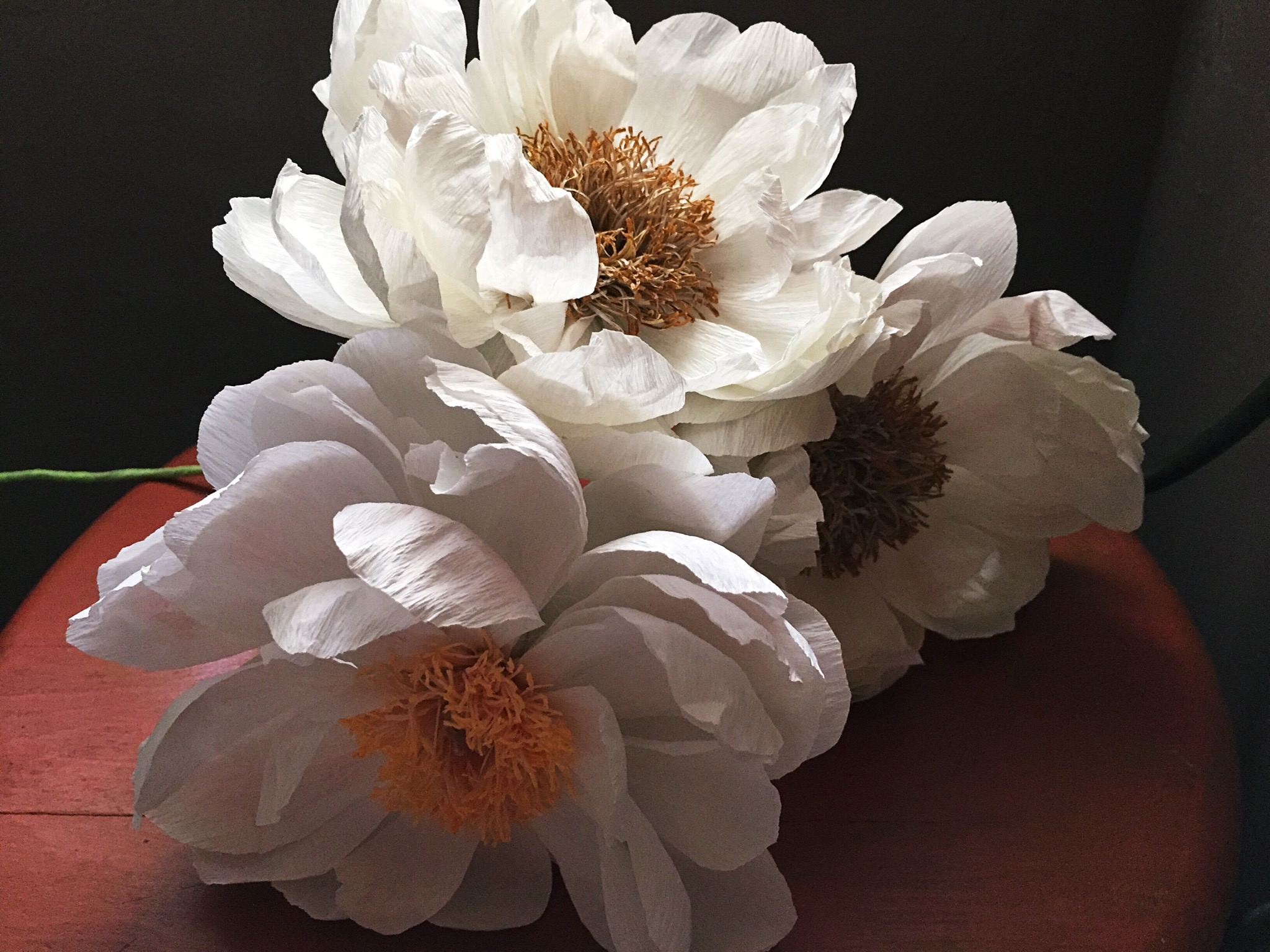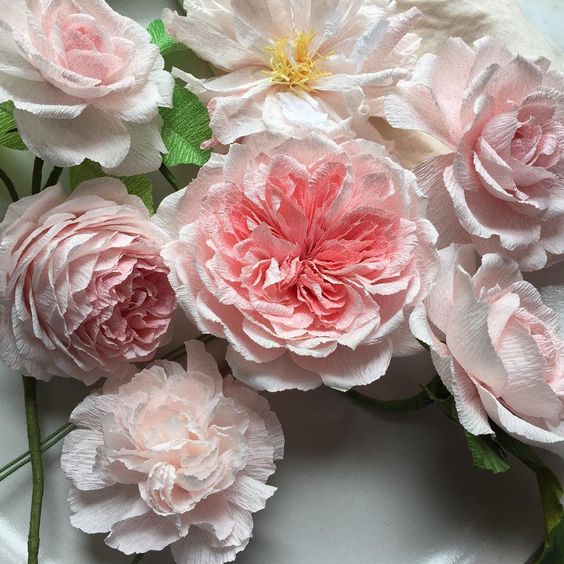TIFFANIE TURNER's FINE ART OF PAPER FLOWERS
mini makerie two : workshop details
NO EXPERIENCE REQUIRED
DAY 1 : tuesday, October 23
Morning:
Our day will begin promptly at 8:30 a.m. with introductions and an outline of the projects we will be creating together over the three days. Tiffanie will also give a brief overview of the crepe papers and other materials we will be working with, and will share sourcing information for all of the materials used.
Using petals pre-cut by Tiffanie, we will dive right in and spend the morning making stunning English Garden Roses. You will learn to work with beautiful ombré crepe paper to create the deep pink centers and the outer white petals, a beautiful effect. Tiffanie will also discuss how to adapt the petals when using softer and more delicate German doublette crepe paper. These roses are stunners on their own, and will be wonderful, voluminous additions to the final bouquet we will put together on Sunday.
Afternoon:
Tiffanie will talk about her love of dead paper flowers and the way she uses her representational botanical work to address conceptual concerns in her art practice. We will spend the afternoon working on gorgeous Faded Coral Charm Peonies, using her unique stamen technique and way of forming, shaping and styling the petals. Adaptations for Claire de Lune and Nymphe peonies will be discussed as well.
DAY 2 : wednesday, October 24
Morning:
Leading into our foliage session, we will begin our second day with an observational walk around the grounds of the farm. The goal is to breathe some fresh air together while we take a closer look at how things grow, specifically getting more intimate with the veins on different leaves and grasses, and talking about how to go about recreating flowers from natural specimens.
Plant foliage can be the centerpiece or just the beautiful finishing touch for a paper flower. This session will be devoted to learning and practicing basic leaf concepts and creating leaves we will need for the flowers we are making, with some tips on making your leaves change with the season. When completed, we will attach our rose and peony leaves to flowers we made on Tuesday.
We will enjoy our lunch while we begin a candid/open conversation surrounding how we each seek balance in our creative, work, and personal lives. Let us discuss what works and how we juggle to find meaningful time for ourselves.
Afternoon:
We will spend the afternoon working on the new darling of modern floristry, the Moth Orchid. Tiffanie will guide you through her special tricks for making a handful of these seemingly simple blooms. A selection of mute, single-tone (non-patterned) papers will be used for this session. These flowers are an interesting departure from the previous day's work, and the basic construction used here can be translated to many other orchid cultivars.
Evening:
We'll share an optional group dinner at a local favorite restaurant.
DAY 3 : thursday, October 25
Morning:
We will spend our final morning together learning to make unique, striking, seasonal Double Daffodil blooms, incorporating several different paper flower techniques into one gorgeous specimen. Working with doublette crepe paper in your choice of colors for the split coronas and petals, you will make a beautiful double daffodil, from stalk to spathe.
Afternoon:
.Our final session will begin with a paper staining demonstration and petal strip cutting lesson. Then, using petal strips prepared in advance by Tiffanie, we will finish by creating the Seussical Pom Pom Poppy. Because poppy leaves are both complex and occur low on the stem, Tiffanie will demonstrate how to make a poppy leaf with the knowledge gained in our earlier paper leaf session, but we will not be adding these to our flowers. We will insert the poppies as final gestures into our large floral arrangement before photographing it.
*Thursday morning session subject to change. Tiffanie creates new flowers throughout the year and may want to bring something new to the table in October.
**Poppy photo credit: Aya Brackett from The Fine Art of Paper Flowers
TIFFANIE TURNER
papelsf.com
Tiffanie Turner was born in 1970 in Colonie, NY and raised in the woods of New Hampshire. She received her Bachelor of Architecture from Rensselaer Polytechnic Institute in 1995 and worked as an architect for over 15 years before beginning her career as a botanical sculptor. She received a Zellerbach Family Grant award in 2016 to support her work as the May 2016 artist-in-residence at the de Young Museum located in San Francisco, where she has resided for over 20 years.
Turner has had solo exhibitions at the Kimball Gallery at the de Young Museum, Tower Hill Botanical Garden in Boylston, MA, and at Rare Device in San Francisco, where she hung her first solo show titled "HEADS" in 2014. Recent group exhibitions include "Beyond the Bouquet" at the Sturt Haaga Gallery at Descanso Gardens in southern California, “Flower Power” at the Asian Art Museum in San Francisco, “Preternatural” at Jack Fischer Gallery in San Francisco, “Detritus” at San Jose Institute of Contemporary Art, and “Botanica” at Bedford Gallery in Walnut Creek, CA. She has been featured in Vogue, American Craft, O Magazine, Sunset, Flower Magazine, and the San Francisco Chronicle, and been noted online by Colossal, Squarespace presents HI-FRUCTOSE, Architectural Digest, My Modern Met, Design*Sponge, Elie Saab, and The Jealous Curator, among others.
Turner is an instructor in the art of paper flower making across the United States and beyond, and is the author of The Fine Art of Paper Flowers, released in August 2017. She is looking forward to her next solo exhibition of large scale work with Eleanor Harwood Gallery at Minnesota Street Project in San Francisco in early 2019.
ARTIST STATEMENT
I am a botanical sculptor who depicts the appearance of different plants, mostly flowers, to some degree of accuracy, in paper, using both realism and preternaturally large, sometimes metastasized forms. My works in paper study scale, texture (petals sometimes reading like feathers, or fur) and color. I work with the rhythms and patterns found in nature, as well as the missteps and irregularities caused by decay, rot, wilt, dormancy, death, and genetic and viral mutations like phyllody, petalody and fasciation. I like to bring the smallest things we take for granted or that might go unnoticed, like the shape of the smallest floret of a flower, right to the viewer’s face, when one may realize they never knew it at all. I like to use the accessible association of botany to tell stories of the state of our environment, of the limits of our society's tolerance of fading beauty, of human vanity and of human compassion.




















